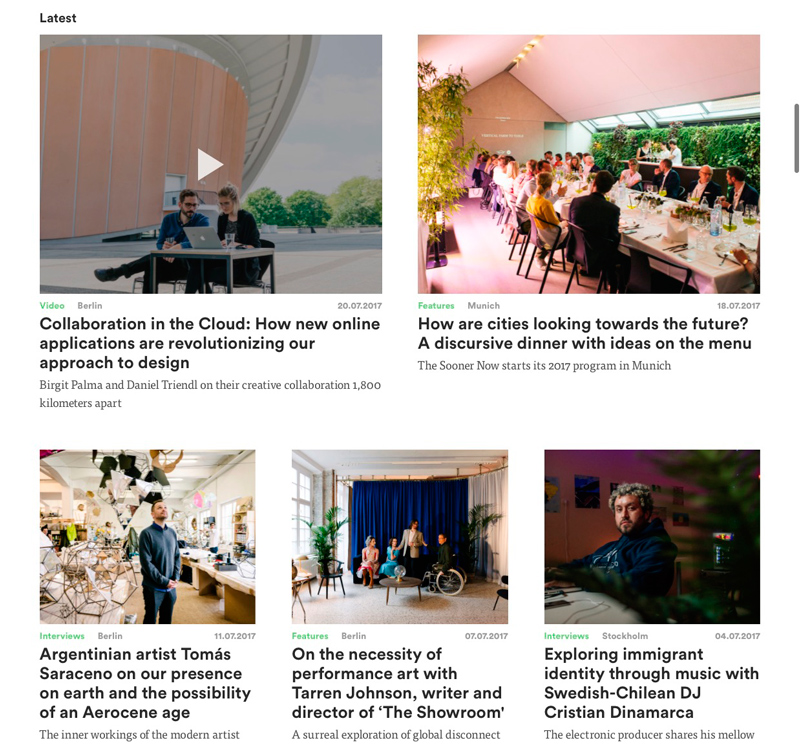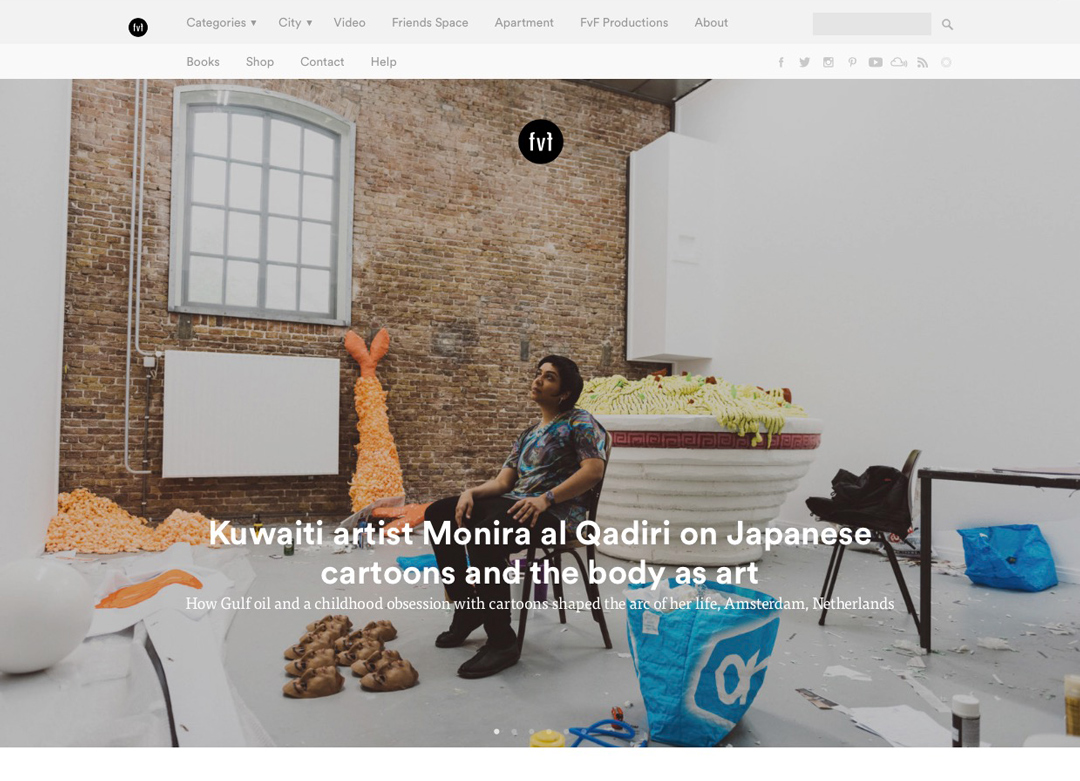Freunde von Freunden is an online magazine about creative culture in various parts of the world. Though they are based in Kreuzberg, Berlin, their international network of contributors allows them to tell a wide variety of stories ranging from travel, art, food, and of course, live/work lifestyle which serve to inspire and inform. Their title, meaning “friends of friends,” represents their tight knit community who share the same values about the above mentioned topics.
I first discovered them as I was conducting research into various publications, both online and in print as the idea of Indievisual was still germinating in my head. Freunde von Freunden [hereafter FvF] have also been producing a series of video interviews to compliment their written interviews in association with varied partners….
(Freunde von Freunden, cont’d)
The first one I ever watched featured SoundCloud co-founder Eric Wahlforss. I was inspired by his account of how Soundcloud was formed and grew (which takes on a strange context in retrospect to events surrounding the company currently). Thereafter I began binge watching other video interviews with creators, artisans, and entrepreneurs in various fields from all over the world. Each subsequent video I watched proved invaluably inspiring as each of the individuals shared a common experience of turning their passion(s) into a career. Through listening to their philosophy regarding their field, the love they exhibit for where they live and operate, as well as their thoughts regarding how their profession or activities can contribute to the community, I became increasingly motivated to move forward with Indievisual (then, still conceptualized as a magazine app). At the time, I was still doubtful if a publication about Japanese independent filmmakers had any chance of succeeding, but each person in the videos and text interviews achieved what the have by maintaining their passion and applying it to include the surrounding spheres in both their professional and personal lives. It slowly began to become apparent to me I was approaching Indievisual in the opposite manner. I needed to make Indievisual for the people I interview rather than a “successful venture” for myself. Beyond this course correction FvF’s content imparted, there were significant influences on the “look & feel” of the Indievisual site as well as the interviews themselves.

The story-centric Freunde von Freunden front page continuing below Feature slider above.
Look & Feel
When you first land on FvF’s website, you’ll notice the clean design and effective typography. It has impressive visual impact. Interviews, Features, and other sections are clearly divided with the latest content made to be as prominent as possible through large feature images. Text support the visuals where it matters most initially, the “front page.” Your attention is first grabbed by the photograph, then the text serves to entice you to read. As a photographer, I appreciated the beautiful feature images of the interviewees. They treated chefs, architects, indie-label owners, graphic designers, etc. in a way I personally was not accustomed; photographing them the same way other magazines treat celebrities and musicians. This led to my decision to also present independent Japanese filmmakers in a similar manner. In order to guarantee this, I created a style guide for filmmaker photographs which strictly forbids them from presenting themselves as “directors” or “producers.” Instead, I required the photographs show them as an individual, and not an occupation, which would also reinforce the magazine’s editorial focus (more on this later).
In terms of the articles themselves, the relationship between photography and text exchange. The visuals become the complimentary element to the text, adding that illustrative element to enhance what you learn from/about the interviewee. Admittedly, I would love to have more photographs of the interviewee in a personal aspect for Indievisual’s articles as well, but at the moment various constraints prevent this. However, at some point in the future, I do aspire to create articles which are as photographically rich as those of FvF. For the time being, the most important design lesson to bear in mind is how these photographs as well as block quotes serve to create a rhythm within the article. Readers’ eyes are given a pause for a block quote or photograph(s), thus preventing fatigue, both for the eyes and mind. A simple, uncluttered design as well as clear, organizational structure is essential in print, but the pitfalls to editorial design are legion for an online publication, especially those which rely on ad support. Indievisual will ultimately go through aesthetic enhancements in years to come, but the presentational lessons learned from FvF will always remain the fundamental framework which forms the reader experience

The rhythmic relation of text and photographs demonstrated in an interview with Tina Roth Eisenberg
Interviews
FvF also provided inspiration through the overall way they engage with creators as people first and foremost. Their interviews do not necessarily focus on their craft, but the lifestyle, beliefs, and community which motivate and sustain it. Thus, I’ve recently attempted to conduct interviews focused less on theory, technique, and style best left to other, more knowledgeable people, choosing instead to illuminate the reasons and mindset which form the basis of their decisions, thus their work. One key element to what makes their interviews enlightening are, of course, the questions they ask their subjects. I’ll go into further detail about misgivings regarding my own questions in a future post, but as I sought to study up on question asking styles, I turned to FvF’s articles as a reference point. The contributors conduct interviews in-person which allows for a conversational style, something I’ve touched upon before as unpractical for Indievisual, but what I’ve manage to glean from their interviews is how their questions are “conversation starters” instead of inquiries intended to obtain information; they warm into those questions by first going in to personal predilections. Of course, it is far easier for them to follow-up and guide the conversation since the interviewee is present with the interviewer, but the relaxed nature of the queries themselves will hopefully help to loosen the admittedly stiff nature of my current question writing style.
Another element which received improvement thanks to FvF’s editorial format are the interviewee introductions. Again, I had first began with rather unremarkable overviews of the subject’s history before FvF illuminated how much more readable and inviting interviewee profiles are when they are written like any other introductory paragraph which plainly yet enticingly states who you are talking about and what the interview will ultimately cover. This seems rather academic in retrospect, but without seeing my own work in comparison to FvF’s articles, I may have never seen the areas where I could improve.
There have been some other minor influences FvF has had on Indievisual. For example, a change in editorial policy led to interviews which were not written in the usual Q&A format, but as quoted answers written in expository form, inspiring what ultimately became the Side Stories section. FvF continues to be a magazine I read frequently, mainly for the enjoyment of their content. The reasons I keep returning to the site and often look forward to what’s new substantiate the elements from which my own publication can benefit. If you’re looking for well-written, engaging profiles of people around the world who balance their passions with their profession, look no further than Freunde von Freunden.
recommended FvF interviews/videos
Joachim Sauter
Mimmi Staaf
Hassan Hajjaj
Erik Spiekermann
Mikio Hasui
Mokena Makeka
Margot Deerenberg
among many others
